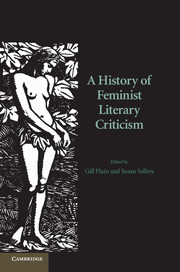Book contents
- Frontmatter
- Contents
- Acknowledgements
- Notes on contributors
- Introduction
- PART I PIONEERS AND PROTOFEMINISM
- PART II CREATING A FEMINIST LITERARY CRITICISM
- Introduction to Part II
- 6 Literary representations of women
- 7 A history of women's writing
- 8 Autobiography and personal criticism
- 9 Black feminist criticism
- 10 Lesbian feminist criticism
- 11 Men and feminist criticism
- PART III POSTSTRUCTURALISM AND BEYOND
- Postscript: flaming feminism?
- Index
- References
7 - A history of women's writing
Published online by Cambridge University Press: 05 June 2012
- Frontmatter
- Contents
- Acknowledgements
- Notes on contributors
- Introduction
- PART I PIONEERS AND PROTOFEMINISM
- PART II CREATING A FEMINIST LITERARY CRITICISM
- Introduction to Part II
- 6 Literary representations of women
- 7 A history of women's writing
- 8 Autobiography and personal criticism
- 9 Black feminist criticism
- 10 Lesbian feminist criticism
- 11 Men and feminist criticism
- PART III POSTSTRUCTURALISM AND BEYOND
- Postscript: flaming feminism?
- Index
- References
Summary
When feminist literary criticism began to emerge in the late sixties and early seventies, bursting into prominence with the publication of such provocative and influential texts as Kate Millett's Sexual Politics (1971), Germaine Greer's The Female Eunuch (1970) and Eva Figes' Patriarchal Attitudes (1970), these pioneering polemics gave surprisingly little attention to women's writing. Paradoxically, in spite of their vigorous attacks on the academic literary establishment, they shared one of its most striking characteristics: they were, as Mary Eagleton has pointed out in the previous chapter, almost solely concerned with men. At that period only a handful of women writers made it on to university English courses. Jane Austen and George Eliot had been placed by Leavis within the great tradition, and were allowed canonical status. Emily Brontë's Wuthering Heights was judged to be a classic, though her sisters, Charlotte and Anne, had their writing dismissed as melodramatic, sentimental and lacking in form. Virginia Woolf was thought overly genteel, far too ladylike to be taken seriously, part of effete Bloomsbury, and even those who praised her, like David Daiches, agreed her art was ‘limited’ (Daiches, 1971: 561). Mary Shelley's Frankenstein, now it seems on virtually every university's first-year English course, was simply not regarded as literature. In Leavis' famous divide between ‘mass civilisation’ and ‘minority culture’, Frankenstein was undoubtedly, like so much women's writing, on the wrong side.
- Type
- Chapter
- Information
- A History of Feminist Literary Criticism , pp. 120 - 137Publisher: Cambridge University PressPrint publication year: 2007
References
- 3
- Cited by

